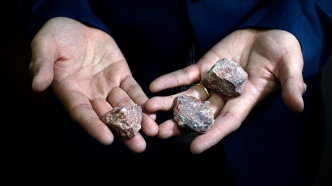
Today, artificially cultivated minerals are not uncommon, such as diamonds, crystals, etc.
The so-called "artificial cultivation" is to simulate the natural conditions of mineral formation in the laboratory to generate minerals. But for 200 years, scientists have been unable to grow dolomite, a mineral in the laboratory, because its natural origin has been controversial. This is also known as the "dolomite problem."
Now, researchers from the University of Michigan in the United States and Hokkaido University in Japan have successfully solved the geological mystery of the "dolomite problem" and achieved laboratory cultivation of this mineral. This is thanks to a new theory they developed from atomic simulations. Relevant research was published in Science on November 23.
In 1791, French geologist Deo Dolomieu first discovered and named the mineral dolomite in the Dolomites in northeastern Italy. It mostly appears in rock formations that are 100 million years old, but it is almost impossible to find traces of it in younger rock formations.
In the more than two centuries since dolomite was discovered, the question of its origin has been at the heart of research debates.
"If we can understand how dolomite grows in nature, we will get new strategies for using modern technology to promote the growth of material crystals." said Sun Wenhao, professor at the University of Michigan and corresponding author of the paper.
Sun Wenhao and others discovered through research that the secret to growing dolomite in the laboratory is to remove mineral structural defects during its growth process.
When minerals form in water, atoms are usually neatly deposited at the edges of the crystal surface. The researchers found that the edges of dolomite crystals are composed of alternating rows of calcium and magnesium. As it grows in water, calcium and magnesium randomly attach to the growing crystals, creating structural defects that prevent rock formations if deposited in the wrong places. This means that dolomite grows slowly, and it may take 10 million years to form an orderly layer of dolomite.
However, these disordered atoms that cause structural defects are more unstable than atoms in the correct position, so when the mineral is washed with water, they are the first to be dissolved, such as through repeated washing by rain or tides, which can remove these defects. Therefore, it actually only takes a few years for the dolomite layer to form. Over geological time, large amounts of dolomite accumulate.
To accurately simulate the growth process of dolomite in the laboratory, the researchers needed to calculate how strongly or loosely the atoms adhered to the existing dolomite surface. And this kind of detailed calculation usually requires strong enough computing power. Therefore, the Center for Predictive Structural Materials Science at the University of Michigan developed a software that provides a shortcut for simulation calculations.
"Our software can calculate the energy of some atomic arrangements and then extrapolate it based on the symmetry of the crystal structure to predict the energy of other atomic arrangements." Brian Puchala of the University of Michigan, one of the main developers of the software, said that the software allows researchers to Modeling dolomite growth on geological time scales.
Today, the few areas where the dolomites formed have intermittent rivers, which flood intermittently and then dry up. This is consistent with the theory of Sun Wenhao et al. But the above evidence alone is not entirely convincing.
To this end, Professor Yuki Kimura of Hokkaido University and his laboratory postdoctoral fellow Tomoya Yamazaki joined the research team of Sun Wenhao and others. They tested the new theory using a transmission electron microscope.
"Electron microscopes usually emit a beam of electrons to image a sample. However, the electron beam splits water, which creates acids that dissolve the crystals. This is usually not good for imaging. But that's what we want," Kimura said.
After placing a tiny dolomite crystal into a solution of calcium and magnesium, Kimura and Yamazaki fired a beam of slight electron pulses 4,000 times over two hours, eliminating defects in the crystal structure. After this the dolomite crystals grew by about 100 nanometers. Although this is equivalent to growing 300 layers of dolomite, more than five layers of dolomite have never been grown in the laboratory before.
The lessons researchers gain from solving the "dolomite problem" could help engineers find techniques for making higher-quality materials.
"In the past, if you want to create defect-free materials, you need to grow them slowly in the laboratory. Our research theory shows that if the structural defects of the material are periodically removed during the growth process, defect-free materials can be quickly grown." Sun Wen Hao said.
Related paper information: https://doi.org/10.1126/science.adi3690